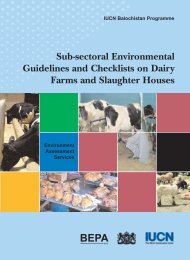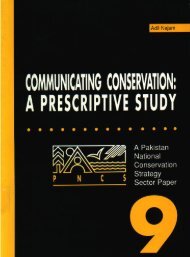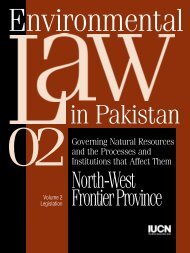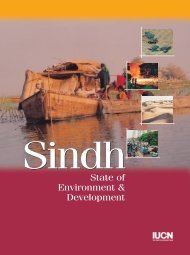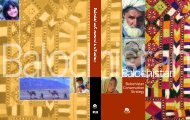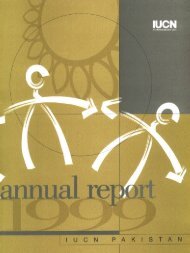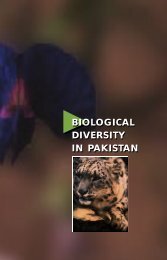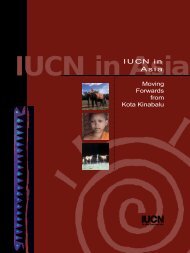Sustainable Fisheries - Pakistan Water Gateway
Sustainable Fisheries - Pakistan Water Gateway
Sustainable Fisheries - Pakistan Water Gateway
You also want an ePaper? Increase the reach of your titles
YUMPU automatically turns print PDFs into web optimized ePapers that Google loves.
development, a cage and culture pilot project,<br />
fish pond development, the establishment of<br />
demonstration and experimental fish farms, and<br />
training and extension services.<br />
The project started in late 1979 and was for<br />
a 5-year duration. Most of the goals have been<br />
achieved and the project provided the initial<br />
thrust that the industry required. As a result,<br />
seed production capabilities have been<br />
increased for both warm and cold water species<br />
and this has been an incentive to potential fish<br />
farmers. The adoption and introduction of new<br />
technology will have a far reaching impact on<br />
fisheries development in the country.<br />
During the last several years much attention<br />
has been paid to the development of reservoir<br />
fishery. WAPDA created an independent directorate<br />
to develop this sector in the reservoirs<br />
controlled by the agency. Several approaches to<br />
improve fish stocks in the reservoirs have been<br />
suggested. The UN Food and Agriculture Organization<br />
(FAO) assisted through a feasibility<br />
study followed by an 18-month pilot programme.<br />
Under this project, a limnological and<br />
fisheries study was commissioned, which was<br />
supposed to form the basis for reservoir<br />
management.<br />
Marine Fishery<br />
<strong>Pakistan</strong> has received technical assistance for<br />
fisheries development from the United Nations<br />
Development Programme, FAO and various<br />
bilateral sources. However, no substantial capital<br />
has been provided to this sector except by<br />
the ADB, which provided US$ 86 million in<br />
loans for three marine and one aquaculture<br />
project. In addition, the European Community<br />
(EC) has provided US$12 million for the rehabilitation<br />
of the Karachi Fish Harbour while<br />
ADB has funded the construction of a new harbour<br />
at Korangi near Karachi. One ADB project<br />
has been completed and others are in various<br />
stages of implementation.<br />
One other port is under construction, at<br />
Pasni. Also funded by the ADB, this is to be completed<br />
at a cost of US$ 27 million. Thus after a<br />
long period of neglect, the government, the ADB<br />
and the EC have made a sizable commitment of<br />
resources to infrastructure development of the<br />
marine fishery. This should help expand fish<br />
landings.<br />
ECONOMIC AND<br />
SOCIAL SIGNIFICANCE<br />
Contribution to<br />
the National Economy<br />
The fishery sector plays a relatively small, though<br />
by no means an insignificant role, in <strong>Pakistan</strong>’s<br />
economy. In 1985 the total value of fish and fish<br />
products was approximately Rs. 4 billion or<br />
about 0.8% of the country’s total GDP. Of this,<br />
about Rs. 1 billion was contributed by the shrimp<br />
fishing, processing and export sub-sector.<br />
Employment in the fishery sector is relatively<br />
small. In 1987, about 250,000 full-time and<br />
part-time fisherfolk as well as fish farmers were<br />
employed. An additional 50,000 people are<br />
probably employed in fish handling, marketing,<br />
processing, boat-building and other related sectors.<br />
In toto, the fishery sector provides employment<br />
to about one per cent of <strong>Pakistan</strong>’s labour<br />
force. In the coastal areas of Balochistan, however,<br />
marine fishery is the central economic<br />
activity and the largest employer.<br />
While fishery contribution to the national<br />
GDP and employment is small, its export earnings<br />
are significant. Exports of fish and shrimp<br />
products in 1986-87 earned about Rs. 1,929<br />
million, that is about 5% of overall export earnings.<br />
Continued expansion of exports from the<br />
fishery sector will, however, have to rely almost<br />
exclusively on fresh and frozen finfish as there<br />
appears to be little potential for expanded<br />
shrimp production from either marine fishery<br />
or aquaculture.<br />
Socio-Economic Conditions<br />
of People Involved in <strong>Fisheries</strong><br />
Fish and fishing activities constitute the main<br />
source of income in the coastal belt of <strong>Pakistan</strong>.<br />
While bona fide fishermen are engaged<br />
NCS SECTOR PAPER 5




